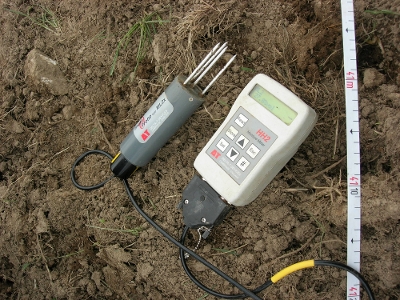Difference between revisions of "Soil moisture - impedance method (Theta Probe)"
(→Links) |
|||
| Line 42: | Line 42: | ||
*John Miller Theta Probe: [http://www.macaulay.ac.uk/MRCS/pdf/tprobe.pdf Theta Probe ML2X Principles of operation and application] | *John Miller Theta Probe: [http://www.macaulay.ac.uk/MRCS/pdf/tprobe.pdf Theta Probe ML2X Principles of operation and application] | ||
*Delta-T Devices: [http://www.delta-t.co.uk/support-article.html?article=faq2005100703502 User Manual] | *Delta-T Devices: [http://www.delta-t.co.uk/support-article.html?article=faq2005100703502 User Manual] | ||
| − | + | ||
*[http://www.sowacs.com sowacs.com] - the central resource for soil moisture measurement | *[http://www.sowacs.com sowacs.com] - the central resource for soil moisture measurement | ||
Revision as of 14:05, 7 November 2013
Parameter to be measured:
Soil moisture, permitivity for a volume of 300mm³ (60mm long x 26.5mm diameter).
Method:
Frequency Domain Sensor working with the so called impedance-method at 100 MHz. Usable in saline soils - up to 2000 mS/m.
Equipment:
- Delta-T Device: Theta-Probe (ML2x) with 4 rods of 600 mm length, HH2 display for manual reading or a data logger
- Reqiuerments to loggers: Requires 5 - 15V DC at 20mA. Provides 0 - 1V DC output.
Advantages:
- easy and fast measurement of punctual soil moisture
- manual as well as continuously logged measurements possible in that case long cable runs possible.
Disadvantages:
- Each sensor has to be calibrated
- careful application of probe in stony and dry soils, because rods break easy
- during field application cable breakes often occures at the crossing between probe head and cable
- Underestimating of permitivity in media with low permitivity (ε > 40, clay and organic soils)
- unaccuarate values in saturated media
What to watch out for:
- Good contact between probe and medium has to be proved
Problems/Questions:
Price:
- 1270 € for probe and reading device (2008)
Links
Projects that used the above equipment:
Other related web sites:
- John Miller Theta Probe: Theta Probe ML2X Principles of operation and application
- Delta-T Devices: User Manual
- sowacs.com - the central resource for soil moisture measurement
References
Blonquist, JM; Jones, SB; Robinson, DA. 2005. Standardizing characterization of electromagnetic water content sensors: Part 2. Evaluation of seven sensing systems. VADOSE ZONE JOURNAL 4(4), 1059-1069.
Gaskin, GJ; Miller, JD. 1996. Measurement of soil water content using a simplified impedance measuring technique. JOURNAL OF AGRICULTURAL ENGINEERING RESEARCH 63(2), 153-159.
Miller, JD; Gaskin, GJ; Anderson, HA. 1997. From drought to flood: Catchment responses revealed using novel soil water probes. HYDROLOGICAL PROCESSES 11(5), 533-541.
Robinson, D.A., Gardner, C.M.K., Cooper, J.D. 1999. Measurement of relative permittivity in sandy soils using TDR, capacitance and theta probes: comparison, including the effects of bulk soil electrical conductivity. Jounral of Hydrology 223, 198-211.
Seyfried, MS; Murdock, MD. 2004. Measurement of soil water content with a 50-MHz soil dielectric sensor. SOIL SCIENCE SOCIETY OF AMERICA JOURNAL 68(2), 394-403.
